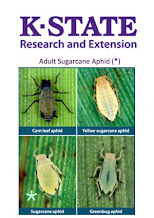Blossom End Rot of Tomatoes
If you are a gardener in Kansas, chances are you have heard of, or seen, blossom-end rot. This condition is most common in tomatoes and shows up as sunken, brown, leathery patches on the bottom of the fruit. It can also cause a problem in squash, peppers, and watermelon crops. You might be surprised to learn that this is not a disease, but actually a physiological disorder caused by a lack of calcium in the developing fruit. This does not necessarily mean that your garden’s soil is lacking calcium. Most Kansas soils are derived from limestone, which is partially made up of calcium.
So, just what is the reason your
tomatoes are rotting? There are actually a number of possible reason, let’s
look at some of them.
1. Heavy
fertilization, especially with ammonium forms of nitrogen, interferes with
calcium absorption. When you over fertilizer, the plant generates more top
growth than root growth. Though tomatoes need to be fertilized to yield well,
too much nitrogen can result in large plants with little to no fruit.
2. Gardening
practices that disrupt the plant roots can also encourage blossom-end rot. This
could be tilling or hoeing the soil too deeply. Mulching helps because it keeps
the soil surface cooler and therefore a better environment for root growth.
3. Tomato tops
often outgrow the root system during cooler spring weather. As long as it stays
cool, the root system can keep up. When it turns hot and dry, the plant has a
problem, and water — with the calcium it carries — goes to the leaves and the
fruit is bypassed. The plant responds with new root growth and the condition
corrects itself after a couple of weeks.
4. Avoid
inconsistent watering. You want to keep the soil moist, but not water logged.
Mulching is a good idea to help retain moisture levels overtime, in the
garden.
You may need a soil test to
determine if your soil has adequate calcium levels. If your soil is deficient
in this nutrient, add 1 pound of gypsum per 100 square feet. Gypsum is calcium
sulfate and will not affect soil pH. Though calcium raises pH, sulfate lowers
pH, and the two will cancel each other out. An application of gypsum will not
cause any harm to your soil, even if the amendment was not needed.
Gardeners may think that spraying
the plant with calcium will be the trick to clear up blossom-end rot. However,
the fruit's waxy surface doesn't allow absorption of externally-applied
calcium, and since calcium needs to be taken up by the roots, a foliar
application will not be effective.
Unfortunately, there are years
that you can do everything right and still have blossom end rot. If this is the
case, remember that blossom-end rot is a temporary condition, and plants should
come out of it in a couple of weeks. Vegetable plants will benefit from picking
off the affected fruits, to encourage new, healthy, fruit formation. It is a
good idea to keep garden records, you may find that certain tomato varieties
are less susceptible to blossom-end rot than others.
Other Common
Tomato Problems:
 |
| Spider Mites on Tomato |
 |
| Tomato Cracking |
 |
| Septoria Leaf Spot |
 |
| Tomato Leaf Curl |









